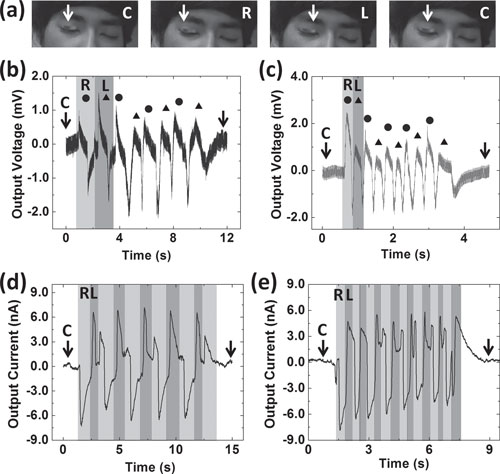| Oct 17, 2013 |
Nanotechnology skin sensor tracks eye ball motion
|
|
(Nanowerk News) Zhong Lin Wang and his team at Georgia Tech have developed a strategy for fabricating ultrathin (∼ 16 µm) nanogenerator, which they demonstrated as an active sensor for monitoring tiny skin deformation.
|
|
The researchers report their findings in the October 14, 2013 online edition of Advanced Functional Materials ("Ultrathin Nanogenerators as Self-Powered/Active Skin Sensors for Tracking Eye Ball Motion").
|
|
The nanogenerator was fabricated based on an ultrathin aluminum foil, on which anodic aluminum oxide (AAO) was created to serve as a blocking layer for electron transport between the aluminum electrode and the grown zinc oxide nanowire film.
|
|
The thin insulating layer plays a key role in the working mechanism of the nanogenerator by creating a high potential barrier between the ZnO nanowires and the electrode. This barrier protects the nanogenerator from short circuiting, but it remains some electrical effects such as dielectric losses and screening effect that can affect the output performances of the nanogenerator.
|
|
Also, since the nanogenerator acts as a charged capacitor, the capacitance of the device and the generated current vary with the thickness of the insulating layer.
|
|
The super-flexible nanogenerator can be applied to the surface of a biological object of any shape due to its high conformability.
|
 |
| Super-flexible nanogenerator as an active sensor for detecting the motion of a human eye ball. a) The nanogenerator attached to the right eyelid was driven by moving the eye ball from right (R), center (C), and to left (L) or from L, C, and R. Output voltage measured under b) slow and c) rapid eye movement. Output current measured under d) slow and e) rapid eye movement. (© Wiley-VCH Verlag)
|
|
The super-flexible nanogenerator demonstrated its great potential to work as an active deformation sensor capable of detecting the eye ball movement when it was attached on the surface of the eyelid for monitoring sleep pattern, tiredness and possible brain activity.
|
|
This strategy can provide a highly promising platform as a self-powered sensor for smart skin applications.
|

